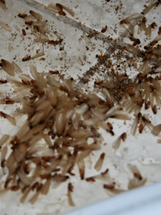Termite Control
Termite Services
Termites are a fact of life in Florida but they’re not all alike, so the first step in initiating proper termite treatment is a thorough inspection of the property to identify specifically which termite is causing the problem. Priority Pest Solution will have a certified inspector examine your home and recommend the best plan for termite control. Best of all, there is no charge for our termite inspection.Drywood Termitesare secretive insects and are difficult to detect. They live deep inside wood and, except during periods when they swarm or when repair work is being done on infested homes, they are seldom seen. Colonies are small (usually fewer than 1,000 individuals), can be widely dispersed, and may take years to mature. A homeowner may initially detect the presence of termites when they swarm or if fecal pellets are is covered; however, inspecting for drywood termites and determining the extent of an infestation requires experience and do-it-yourself treatments are not recommended. Every year, the amount of damage caused by Subterranean Termites in Florida far exceeds that caused by fires and storms combined — several times over, in fact. As the name implies, these termites live in underground colonies numbering in the hundreds of thousands, utilizing pipes and cracks in concrete floors to enter an unprotected home. Each colony, consisting of four different “castes” of individual termites, relies on moisture for survival and builds mud-tube tunnels to reach food sources above ground behind your walls and under your floors.
Drywood Termites
Appearance:
Drywood termites are yellow to pale brown in color. The bodies of primary reproductives, also called swarmers or alates, vary by species from coal black to pale yellow-brown, with grayish wings that extend past their bodies. Soldiers are pale to dark yellow and have large, visible jaws or mandibles.
Behavior:
Drywood termites are social insects that live in highly organized colonies. The colonies are composed of reproductives, workers, and soldiers. Small swarming flights, marked by the presence of swarmers, occur during April through July, frequently after rains. These reproductive termites can be winged or wingless. Colonies are small, can be widely dispersed and take years to mature. Unlike subterranean termites, they do not require any contact with soil in order to thrive; they get the moisture they need to live from humid air or by digesting cellulose from wood. For this reason, drywood termites are most common along humid coastal areas. Indoor infestation is often detected by the presence of shedded wings from swarmers. The presence of small fecal pellets, called frass, can be found outside of infested wood. The termites expel them through tiny openings in the infested wood made by the termites for this purpose. Because of their ability to live in wood without soil contact, drywood termites may attack wood products of all kinds and may infest any dry wood portions of a house from the foundation to the roof.
Subterranean Termites
Appearance:
Formosan subterranean termite workers look similar to those of native subterranean species. Soldiers are different in that they orange=brown-oval shaped heads with black mandibles. Swarmers are yellowish-brown with 2 pairs of wings of equal length. They are about 1/2 to 3/5 inch long from head to wingtip. The wings are covered with small hairs.
Behavior:
The Formosan subterranean termite has been transported worldwide from its native Southern China to Formosa, Taiwan- where it gets its name - and Japan. Within the last 100 years it has become established in South Africa, Hawaii and the continental United States. Sometimes referred to as the “Super Termite”, Formosan subterranean termites produce very large colonies, with the territory of a single colony sometimes reaching 300 feet. They can infest a wide variety of structures, including boats and high-rise condominiums. Termite swarms tend to occur from April through July on warm, humid evenings A single Formosan subterranean termite individual does not consume more wood than a single native subterranean termite; however, because of its large population size, a Formosan termite colony can cause more structural damage in a shorter time.
Although they start small, a single Formosan termite colony may produce over 70,000 alates. The nest starts small, with only one batch of eggs, and may take from 3-5 years before the colony reaches substantial numbers. However, they can swell to huge capacities, with colony containing several million termites.
Formosan Termites
Appearance:
Formosan subterranean termite workers look similar to those of native subterranean species. Soldiers are different in that they orange=brown-oval shaped heads with black mandibles. Swarmers are yellowish-brown with 2 pairs of wings of equal length. They are about 1/2 to 3/5 inch long from head to wingtip. The wings are covered with small hairs.
Behavior:
The Formosan subterranean termite has been transported worldwide from its native Southern China to Formosa, Taiwan- where it gets its name - and Japan. Within the last 100 years it has become established in South Africa, Hawaii and the continental United States.
Sometimes referred to as the “Super Termite”, Formosan subterranean termites produce very large colonies, with the territory of a single colony sometimes reaching 300 feet. They can infest a wide variety of structures, including boats and high-rise condominiums.
Termite swarms tend to occur from April through July on warm, humid evenings A single Formosan subterranean termite individual does not consume more wood than a single native subterranean termite; however, because of its large population size, a Formosan termite colony can cause more structural damage in a shorter time.
Although they start small, a single Formosan termite colony may produce over 70,000 alates. The nest starts small, with only one batch of eggs, and may take from 3-5 years before the colony reaches substantial numbers. However, they can swell to huge capacities, with colony containing several million termites.









